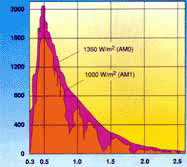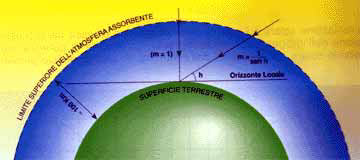Solar radiation

Solar radiation is the electromagnetic energy produced by fusion processes of the hydrogen contained in the sun.
The intensity and the spectral distribution of the solar radiation that arrives on the Earth's surface depends on the composition of the atmosphere. On the ground solar energy is concentrated in the wavelength interval of 0.2-2.5 micrometers:
0.2 - 0.38 micrometers = ultraviolet (6.4% of the total energy contained in the spectrum)
0.38 - 0.78 micrometers = visible (48%)
0.78 - 10 micrometers = infrared (45.6%)
The useful wavelength for crystalline silicon photovoltaic cells begins at 0.35 micrometers and includes the whole infrared range. The maximum intensity of solar energy lies between 0.5 and 0.55 micrometers.
Extraterrestrial radiation ("solar constant"): 1.367 W/m² ± 3,3 % (to account for the varying Earth-Sun distance as the Earth orbits the Sun)
To consider the effects of the atmosphere, scientists have defined what is known as the unitary mass of air AM1 (Air Mass one), representing the standard density of atmosphere perpendicular to the plane of the Earth's surface, measured at sea level.
AM = (1 - 0.1 * altitude)/sin HS that can be approximated to : 1 / sin HS, where HS is the angle of the sun's elevation (angle between the rays of the sun and the horizontal plane)
Air Mass outside the atmosphere: AM = 0
With an angle of solar elevation HS equal to 90°: AM = 1
With HS equal to 42°: AM = 1,5 (this is the AM which is considered in laboratory tests on photovoltaic modules, for defining the power of the rated output).

Comparing the spectrum of solar radiation on the ground in AM1 conditions to the spectrum of extraterrestrial radiation in AM0 conditions, one sees in the former the presence of numerous holes, not present in the AM0 spectrum, due to: 1) the absorption caused by molecules of water and air vapour and by atmospheric dust and 2) the reflection in space.
Global solar radiation = Direct + Diffuse + Reflected ( = 1.000 W/m²) In winter there is a much higher percentage of diffusion..
The amount of diffuse solar radiation is annually equal to 55% of global radiation.
In calculating the size of photovoltaic solar systems one should consider the albedo coefficient, which measures the reflection given by the ground. This coefficient therefore depends on the type of ground.
Some examples:
Grass: 0,15 - 0,25
Fresh snow: 0,82
Dry tarmac: 0,09 - 0,15
The intensity of solar radiation on the ground depends on the angle of inclination of the radiation itself: the more acute the angle that the sun's rays form with the horizontal surface the denser the atmosphere they have to travel through, meaning less radiation reaching the surface.

Systems of measurement (solarimeters):
- Pyranometer: 2 thermocouples (one facing the light, the other behind, in the dark). The difference in tension between the 2 determines the irradiation. Expensive, accurate (1%).
- Cells of reference: based on a small photovoltaic cell. Costs less, is less accurate (5%).
Tables of solar radiation (diffuse + direct) --> kWh/m² day: one for every month of the year, in order to correctly calculate the size of the plant, depending on what it is used for.
At our latitude the optimal tilting of the panel of modules (or solar thermal collectors) is approximately 35°, enough to maximise the energy picked up during the course of the year. In cases where the system is mainly used in the winter months, the panel will have to be tilted at an angle of 55°-60°. These angles may differ from place to place, even if they are on the same latitude, due to the variability of direct and diffuse components found in different areas.

